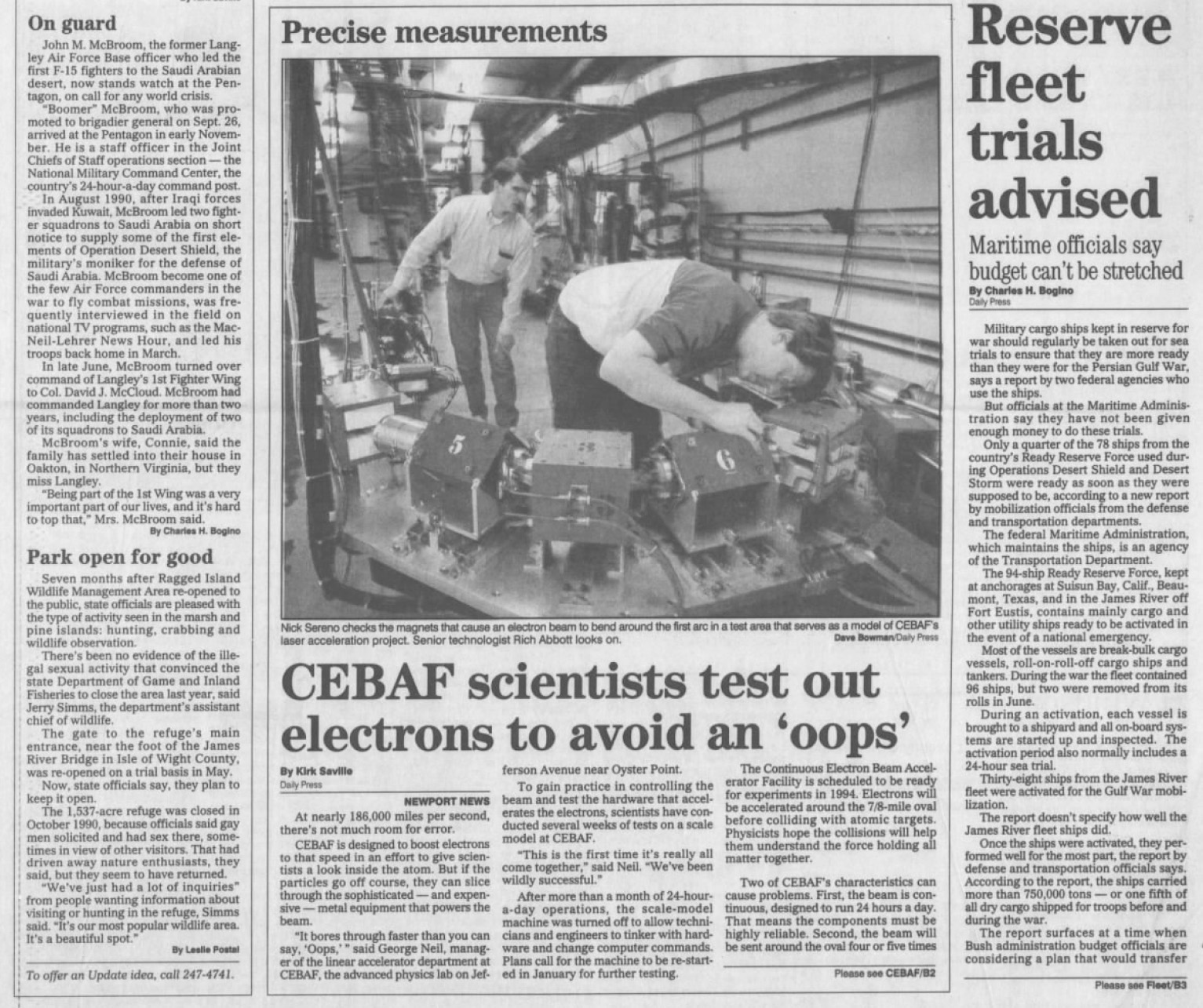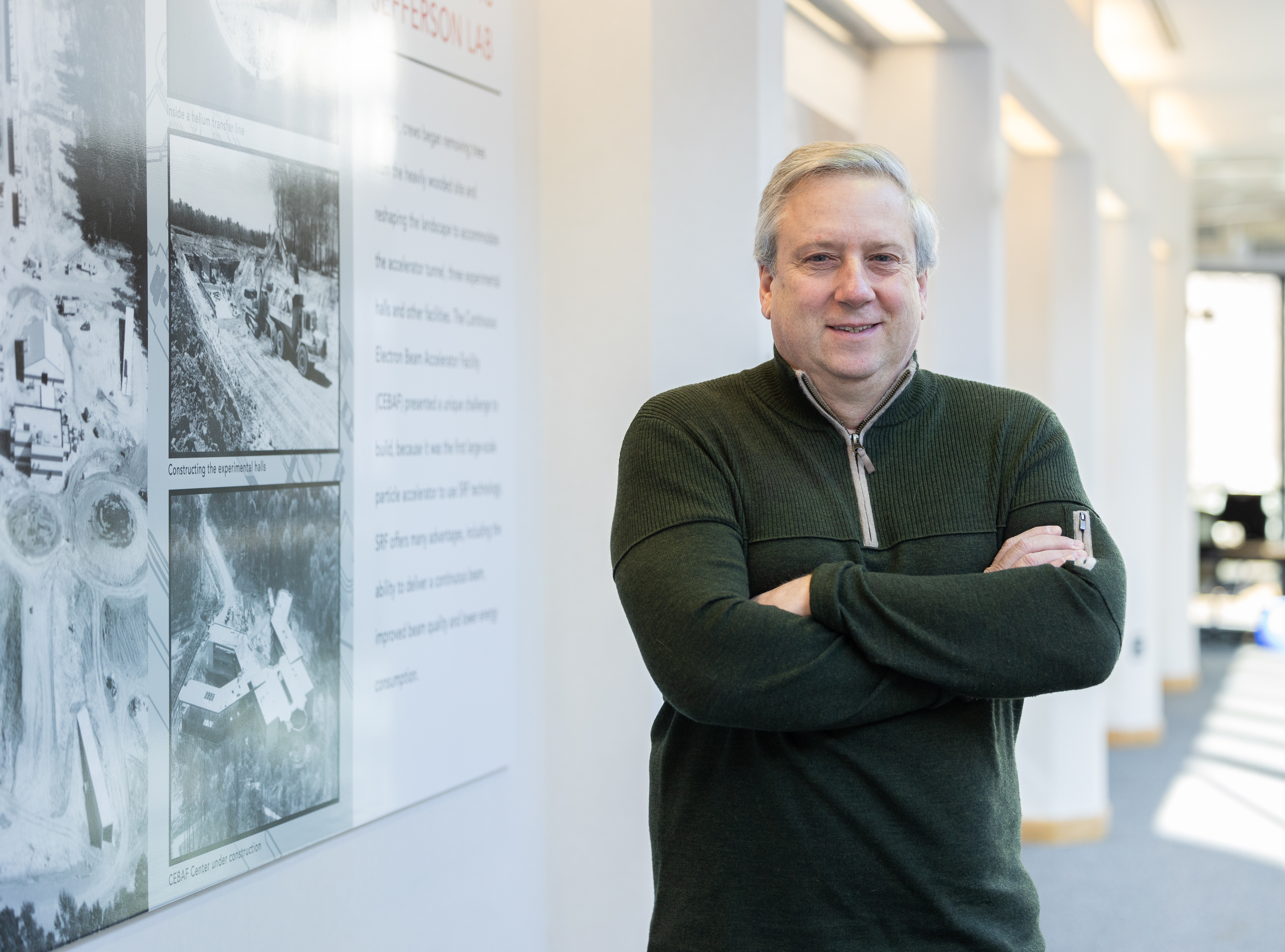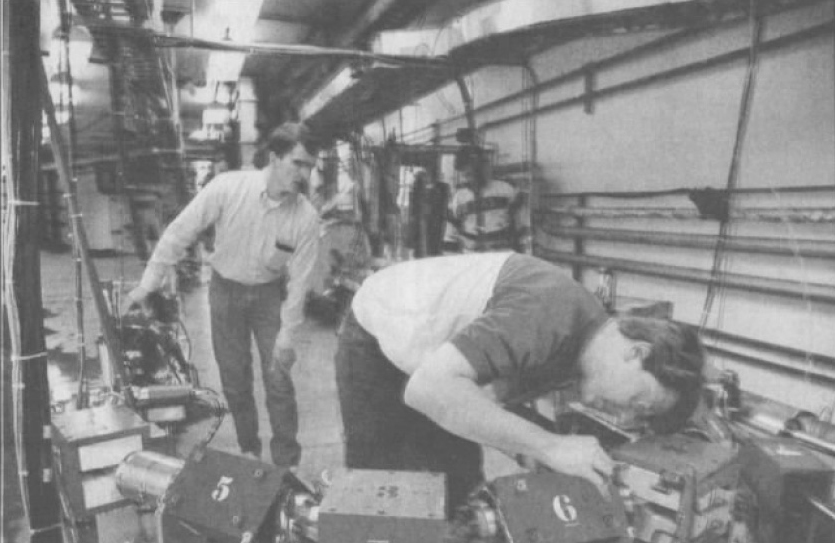(Jefferson Lab and Daily Press photos)
Injector setup in early 1990s informed research machine’s development, inspired future technologies, and launched one Jefferson Lab physicist’s full-circle career
NEWPORT NEWS, VA – When construction of the U.S. Department of Energy’s Thomas Jefferson National Accelerator Facility ramped up in the early 1990s, the lab’s surroundings weren’t as citified as they are today.
Just down the main drag in Newport News’ growing retail corridor was a large, grassy pasture. There, an old dairy barn and milk house defied the inevitable urban overspill. Beyond a thick stand of towering Virginia pines nearby, scientists at Jefferson Lab were testing a miniature version of the enormous particle accelerator being built in a racetrack-shaped tunnel underground.
The rural vestiges have since given way to sprawling shopping plazas, apartments and an ultramodern research park in what has become the coastal Virginia city’s commercial and innovation hub. Meanwhile, the lab and its primary research machine, the Continuous Electron Beam Accelerator Facility (CEBAF), also have come a long way.
“The area around the lab seems so different, 30 years later,” said Nick Sereno, an accelerator physicist who first came to Jefferson Lab as a graduate student in 1989 and recently returned after three decades at DOE’s Argonne National Laboratory. “It was not nearly as built up.”
Now a world-class DOE Office of Science user facility supporting the research of more than 1,650 nuclear physicists exploring the heart of matter, CEBAF was envisioned in the mid-1980s as a first-of-its-kind, continuous-beam electron accelerator. Its driving force would be resonant cavities crafted from ultrapure niobium. Jefferson Lab pioneered the large-scale installation and operation of this novel superconducting radiofrequency (SRF) technology, used to propel electrons to more than 99.999% the speed of light.
The cavities and their supporting components are stuffed into hulking steel cylinders to form cryomodules, the backbone of many high-power accelerators. CEBAF has more than 50 cryomodules, each with its own nickname, and one is now influencing the next generation of SRF tech.

Avoiding an ‘Oops’
Gray Ghost II was the first cryomodule to be installed in CEBAF, in 1990. A year later, the supercooled behemoth was part of an experiment featured in a Daily Press story with the headline, “CEBAF scientists test out electrons to avoid an ‘oops.’ ”
Gray Ghost II was part of the accelerator’s injector, which is the source of CEBAF’s electrons. While CEBAF’s remaining cryomodules were being installed, scientists and engineers sought a way to test electrons’ ability to run laps in a recirculating beamline.
Sereno was working with Jefferson Lab’s accelerator group as a Ph.D. student from the University of Illinois Urbana-Champaign. The group had built an 80-foot scale model of the 7/8-mile CEBAF, using Gray Ghost and another cryomodule to drive an electron beam during two passes through the loop.
The “oops” to be avoided was a condition called multipass beam breakup, where an electron beam breaks apart as it rounds the accelerator’s bends, potentially damaging components. The CEBAF model proved stable against this and was the subject of Sereno’s Ph.D. thesis.
“It was a big deal for the lab,” Sereno said. “The experiment demonstrated recirculation through these SRF cavities for the first time.”
Sereno completed his Ph.D. in 1994. That year, CEBAF smashed its first electrons into an atomic target.
Fast forward to today, and Gray Ghost II has inspired another first for cryomodules. Gray Enid I, a new prototype named after Gray Ghost and recently dedicated at Jefferson Lab, is the first to feature SRF cavities made from niobium-tin.
Niobium-tin is a metal alloy that becomes superconducting with less refrigeration than ultrapure niobium. The technology promises to cut costs for future SRF accelerators and enable compact machines for future industrial uses.

You Can Go Home Again
Ph.D. in hand, Sereno joined the staff at Argonne. The job was a homecoming of sorts for the northern Illinois native.
During his nearly 30-year career there, Sereno was instrumental in the commissioning of the original Advanced Photon Source (APS) and an eventual brightness upgrade of the high-energy X-ray light machine. APS X-ray beams are used in an array of research disciplines, including materials science, chemistry, condensed matter physics, and life and environmental sciences.
The APS upgrade was essentially a complete overhaul, with most of the existing components ripped out and new ones built from scratch. Among those replaced parts were large magnets and vacuum chambers sent to Jefferson Lab to be repurposed for use in the future Electron-Ion Collider (EIC) being built at DOE’s Brookhaven National Laboratory. Jefferson Lab is a partner with Brookhaven Lab in the design and establishment of the EIC.
The EIC will be a network of accelerators centered around a 2.4-mile ring. The next-generation collider is designed to unlock new secrets about the universe’s building blocks and challenge the Standard Model of particle physics.
Following the APS upgrade, Sereno saw a conceptual design report for the EIC. He learned that many of the components would be built at Jefferson Lab, so he reached out to its Center for Advanced Studies of Accelerators.
“With the new APS machine fully designed and nearly ready for commissioning, I thought it would be nice to try something new,” he said.
Sereno rejoined Jefferson Lab in early 2024, and now he’s helping design technologies for the highly complex collider.
“In order to realize the full physics potential of the EIC, colliding a high-energy electron beam with a high-energy proton beam, you have to create several accelerators that work in concert,” Sereno said. “For an accelerator physicist, it's pretty exciting.”

Full Circle
The cow pasture had long since been paved over before Sereno’s return to Newport News, but the Yoder barn is preserved as a local landmark – and an oddity in the city’s bustling shopping district. Much of the surrounding woodland was chopped down to make way for further development around Jefferson Lab, which is now a 179-acre federal site with 71 DOE-owned buildings.
“I never saw the cows, but I remember Jefferson Avenue near the lab as mostly going through forests,” Sereno said. “The whole area, including the lab, has grown tremendously since then.”
Some of the vacuum chambers sent to Jefferson Lab from Argonne’s original APS couldn’t be repurposed for the EIC and were destined for the scrap heap. But instead of recycling the materials, the lab crafted them into giant LOVE letters that are now a permanent display on the lab’s campus.
Known as LOVEworks, the art installations can be found in unique destinations throughout Virginia and are an extension of the state tourism corporation’s Virginia is for Lovers® brand. The new, accelerator-inspired sculpture was unveiled in 2024 as part of the lab’s 40th anniversary celebration and was a main attraction during that year’s open house.
“When we were building the original APS, all that equipment was so delicately and pristinely handled,” Sereno said. “A few parts of those are outdoors now, but it’s nice to see them find new life.”

Further Reading
Jefferson Lab Timeline
Benchmarking CEBAF
Jefferson Lab Dedicates Niobium-tin Particle Accelerator Prototype
Experimental Studies of Multipass Beam Breakup and Energy Recovery Using the CEBAF Injector Linac (Thesis/Dissertation)
CEBAF Scientists Test Out Electrons To Avoid an ‘Oops’ (Daily Press article from Dec. 30, 1991)
Selling the Farm (Daily Press article from Sept. 24, 1995)
Electron-Ion Collider (EIC)
The Advanced Photon Source
Argonne to recycle magnets from Advanced Photon Source in new physics experiment at Brookhaven
Newest LOVEwork Unveiled in Newport News
Contact: Matt Cahill, Jefferson Lab Communications Office, cahill@jlab.org



